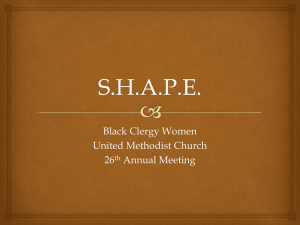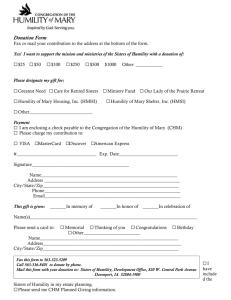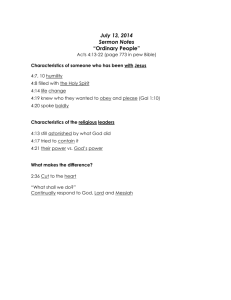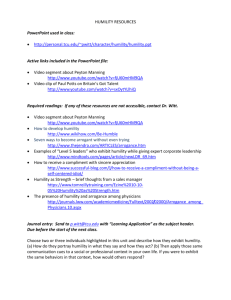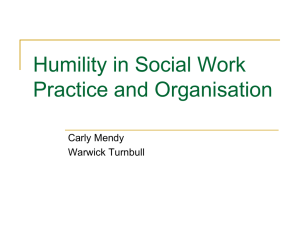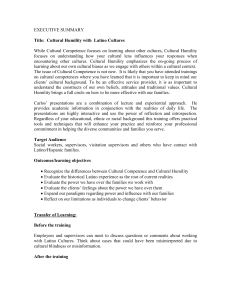Cultural Humility: Identity Negotiation Workshop Part 3
advertisement
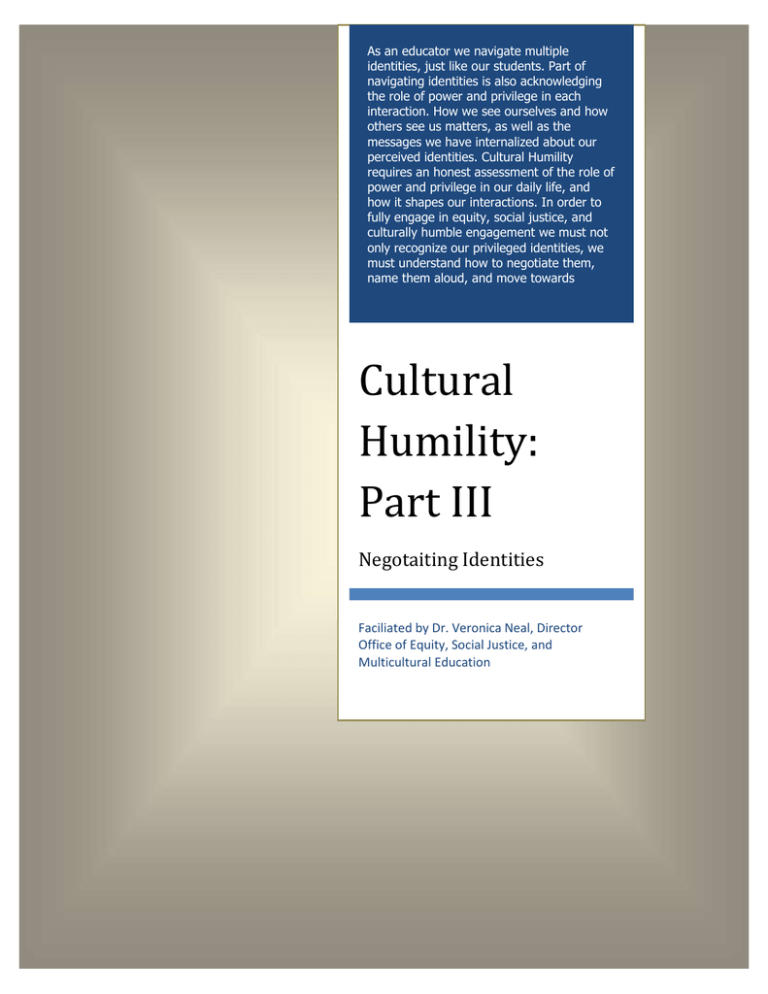
As an educator we navigate multiple identities, just like our students. Part of navigating identities is also acknowledging the role of power and privilege in each interaction. How we see ourselves and how others see us matters, as well as the messages we have internalized about our perceived identities. Cultural Humility requires an honest assessment of the role of power and privilege in our daily life, and how it shapes our interactions. In order to fully engage in equity, social justice, and culturally humble engagement we must not only recognize our privileged identities, we must understand how to negotiate them, name them aloud, and move towards alliship. This workshop will examine power and privilege in the academy, navigating personal identities, and ally behavior. Cultural Humility: Part III Negotaiting Identities Faciliated by Dr. Veronica Neal, Director Office of Equity, Social Justice, and Multicultural Education WELCOME AND OVERVIEW Broad Workshop Goal: To review the concept of cultural humility and the skill of identity negotiation as a prerequisite to culturally humble practice Expected Outputs -- By the end of this workshop participants will be able to: 1. 2. 3. 4. 5. Review cultural humility and related skills for integration. Articulate more clearly the importance of identity negotiation in cultural humility. Reflect on personal identity in the classroom. Examine aspects of power and privilege as informing identity variables. Explore ways to negotiate identity for greater ally behavior. Starting Equity Assumptions: We all want to be here for the good of the entire college community There are more questions than answers This is an ongoing learning process We are equals – peers- in this learning space, working together for our students Our values, cultural identities, and past experiences matter Conflict is always possible, and conflict is OK when addressed from the heart We are all prejudiced; prejudice is learned and can be unlearned We are here to learn from each other Personal Hopes and Expectations: 1 Cultural Humility: Identity Negotiation AGENDA Welcome/Overview Agenda Contracting Pair-share: Today’s work Cultural Humility as a Path to Institutional Equity Cultural Humility Review and Dialogue BREAK Personal Identity and Values Individual Power and Privilege Institutional Power and Privilege Identity Negotiation and Ally Behavior 2 Cultural Humility: Identity Negotiation FOUR-FOLD WAY: PRINCIPLES TO GUIDE A LEARNING COMMUNITY Summarized by Michael Welp, Ph.D., www.equalvoice.com Angeles Arrien is a cultural anthropologist who has studied the common ways indigenous cultures throughout the world support creative expression, health, and adaptation to change. She has developed four major principles that integrate ancient cultural wisdoms into contemporary life. These principles provide clarity for thriving in today’s complex world of constant change. 1. Show up, or choose to be present. Being present allows us to access the human resources of power, presence, and communication. This is the way of the leader. We express the way of the leader through appropriate action, good timing, and clear communication. 2. Pay attention to what has heart and meaning. Paying attention opens us to the human resources of love, gratitude, acknowledgment, and validation. This is the way of the healer. We express the way of the healer through our attitudes and actions that maintain personal health and support the welfare of our environment. 3. Tell the truth without blame or judgment. Truthfulness, authenticity, and integrity are keys to developing our vision and intuition. This is the way of the visionary. We express the way of the visionary through personal creativity, goals, plans, and our ability to bring our life dreams and visions into the world. 4. Be open to outcome, not attached to outcome. Openness and non-attachment help us recover the human resources of wisdom and objectivity. This is the way of the teacher. We express the way of the teacher through our constructive communication and informational skills. Optimum health is expressed in most cultures as a balance in all four areas: leading, healing, visioning, and teaching. Cross-culturally these four areas reflect the four human resources of power, love, vision, and wisdom. For an in-depth exploration of these principles, read Angeles Arrien’s The Four-Fold Way: Walking the Paths of the Warrior, Teacher, Healer, and Visionary, published in 1993 by Harper SanFranciso. For more information on Angeles Arriens’s workshops, publications, and activities, request her newsletter by phone at 415-331-5050 or visit her website at www.angelesarrien.com. 3 Cultural Humility: Identity Negotiation CONTRACTING I, _____________________________________________________ Understand that it is okay to be imperfect with regard to my understanding of people who are different from me. I give myself permission to reveal ignorance and misunderstanding. I give myself permission to struggle with these issues and to be open and honest about my feelings. I am a product of my culture, upbringing, environment, and experiences, and “I am who I am” – and I am okay! I do not have to feel guilty about what I believe, but do take responsibility for: __ Letting go of my role of teacher in this space and opening to my role as learner, __ Accepting as much new information and knowledge as I can, and __ Challenging myself to examine my assumptions and beliefs. __ I grant myself permission to accept and appreciate the other members of the group as they also struggle with these issues and to be open and honest about their feelings. __ I agree to respect the confidentiality of all the personal information shared in both our small and large group work. ___ Today, I am committed to working on the following areas: ___________________________________ _______________________________________ _____________________________________Signature Adapted with permission for educational use only from Professional Development Group, Inc. 1993 © 4 Cultural Humility: Identity Negotiation CULTURAL HUMILITY AS A PATH TO EQUITY What is the difference between equity and equality? What is the difference between diversity, deficit, and equity focus? 5 Cultural Humility: Identity Negotiation WHAT IS CULTURAL HUMILITY? Cultural humility is a lifelong process of self-reflection, self-critique and commitment to understanding and respecting different points of view, and engaging with others humbly, authentically and from a place of learning (Tervalon & Murray-Garcia, 1998). Tervalon and Murray-Garcia developed this concept while addressing disparities and institutional inequities in the field of public healthcare. Cultural humility is a unique framework for moving us toward equity. It is a philosophy that addresses the role of power and privilege in a system, as well as the imbalanced power of voice and power to make decisions (i.e., the power over and the power to). Moreover, it is critical to ensure campus commitment and consistency across policies and procedures. Understanding institutional, interpersonal and internalized oppression is also an essential and ongoing aspect to this approach to organizational transformation. Cultural humility upholds each individual or community group as the experts and teachers on the content of their personal culture. Thus, creating time and space for sharing personal stories, worldviews, approaches to trust building, team building, and community dynamics should become part of the day-today strategy for inclusion and our campus community development. Cultural humility asks that we meet each person where he or she is by suspending judgment and resisting the need to impose personal values, beliefs, “truths,” and notions of right and wrong. By doing so, we reduce the harm of prejudice and oppression and open opportunities for equity. Meeting each person where he or she is, challenging and naming assumptions and biases, sharing the hidden rules of success, and redefining the cultural norms of an organization are part of deepening individual and campus cultural humility. LEARNED SKILLS FOR CULTURAL HUMILITY APPLICATION Skilled Dialogue (authentic communication without defensiveness, nonjudgmental, seeking to learn and understand vs. pushing an agenda, not a discussion or debate) Negotiation (power analysis, shared-decision making, ability to change/flexibility) Self-reflection and Critique (reflective practitioner, identity politics… what’s in it for me?) Transformational Conflict (difficult conversations, real-time feedback, observational learning) Inquiry (personal and group, coaching conversation, powerful questions) Reference: Neal, V. (2010) 6 Cultural Humility: Identity Negotiation Dialogue Reflection Inquiry Individual Transformation and Social Consciousness Conflict VAKN 2010 7 Cultural Humility: Identity Negotiation Negotiation CULTURAL HUMILITY REFLECTION AND DIALOGUE Small Group Discussion Questions: 1. Describe a time when you observed or felt someone approached you with great cultural humility. a. What was the situation? What was the effect? b. What was your power relationship to them? 2. Think, now, about a time when you observed or felt someone approached you with a great degree of cultural arrogance. a. What was the situation? What was the effect? b. What was your power relationship to them? 3. Describe a time when you’ve been deeply challenged and still brought forward your own cultural humility. a. What was the situation? What was the effect? b. What was your power relationship to them? 8 Cultural Humility: Identity Negotiation NEGOTIATING IDENTITIES: A BRIEF SUMMARY By Dr. Veronica Neal, 2010 Negotiation is a complex process that is also critical to the ongoing process of cultural humility self-identity development. Negotiation is defined within this conceptual framework as the process of identifying perceived personal and social realities, as well as how practitioners challenge self-identity and others in different cultural milieus. Individuals are always negotiating their social realities—some more than others because their narratives, or identities, are more privileged than are those of others. Understanding how to negotiate power and privilege, personal identity, and social realities creates openings for introducing new perspectives into one’s cultural framework. This process is a skill that with practice becomes an automatic response to one’s ever-changing environment, resulting in the dispositional identity of negotiation. Negotiation is also an essential element in managing conflicting views of the self and others. Nierenberg (as cited in Kellett & Dalton, 2001) defined this process as follows: “Whenever people exchange ideas with the intention of changing relationships, whenever they confer for agreement, they are negotiating” (p. 18). Hayes’s (1989) definition of negotiation underscored the importance of power, which is also an informing dynamic in cultural humility, as operationalized by Tervalon and MurrayGarcia (1998). Hayes explained that power dynamics surface in negotiation when individuals or groups are at an impasse and there is also a lack of power, or a willingness to assert power in hopes of achieving a specific outcome. Acknowledging and addressing the role of power and privilege also distinguishes diversity education approaches. Those that tend to maintain the status quo or avoid disrupting the normative, or dominant, cultural paradigm contrast with approaches that more directly identify institutional oppression (e.g., the anti-racism and cultural humility approach) (DeRosa, 2001). However, approaches that identify imbalances of power and privilege as critical to institutional change and inequity do not aim to blame, shame, victimize, or embarrass those who hold power and privilege in a given context. In fact, such an approach would push against the very essence of humility. Kellett and Dalton (2001) pointed out that negotiation allows for the process of asking useful questions about conflict, considering what created the conflict, and selecting the best strategies for moving through a particular conflict. Whenever a difference exists—and differences (diversity) are always present—so will be conflict. Differences inform one’s perceptions of reality, as well as one’s worldview, beliefs, and values. Moving through conflict means also renegotiating reality. As stated by Kellett and Dalton (2001), “the negotiation of reality occurs through the patterns of how people create agreements through conflict…the conflicted dimensions of a narrative give you clues about the quality of negotiation creating…everyday reality together and their social reality more generally” (p. 95). In other words, relationships, conflict communication style, cultural identities and narratives, negotiation, and change are indelibly interlinked. “Upon initiating relationships, people engage in a process of identity negotiation through which they establish their respective identities. Once established, people’s identities define their mutual expectations, obligations, and indeed, the very nature of their relationships.” – Swann, Johnson, & Bosson, 2009 9 Cultural Humility: Identity Negotiation PERSONAL IDENTITY Instructions: Step 1. In small groups share your thoughts on personal identity and what you believe shapes identities. Together, please brainstorm a working definition of “identity” for the group. Step 2. Please reflect on your personal identity and develop a collage that reflects the key aspects of who and what you are or how you identify. You may use pictures, quotes, words, etc. Step 3. Please return to your small group and share your collage before discussing the following: Where do identities come from? How do the different parts of your identity give you power? How your identity is different from the ways people might perceive you? Which aspects of your identity are easily visible to others? Which aspects are less visible? In what ways is your identity made up of more than one layer? What are some of these layers? Which aspects of your identity are easiest to share in school and/or in your student club? Why do you think this is the case? A person’s identity is a group of characteristics that make up who they are. A characteristic is a distinguishing feature or quality, such as being a person of color, a book lover, a sibling or a swimmer. Each person’s identity is unique and special because it is made up of different characteristics. Although people may share characteristics, no two identities are exactly the same. Questions on page 8-10 Adapted from GLSEN Jump-Start Guide 10 Cultural Humility: Identity Negotiation PERSONAL POWER AND PRIVILEGE 1. In what situations and contexts are you most aware of your own privilege? 2. In what situations and contexts are you most aware of your own power? 3. What is the difference between privilege and power? 4. Whether consciously or unconsciously, how have you used your privilege, both as an individual and as a member of various groups? 5. How do you acknowledge that you have privilege or that you don’t have privilege? 6. How do you feel talking about power and privilege? Why? 11 Cultural Humility: Identity Negotiation INSTITUTIONAL POWER AND PRIVILEGE Instructions: 1. In your small groups, discuss power and privilege. What is power? A good definition of “power” is “the ability to get what you want.” Groups and individuals both pursue and exert power. On an individual level, people find power within themselves in different ways; what makes one person feel powerful may not make someone else feel the same way. For example, one person might find power in being tall, while another person might feel that being tall diminishes their ability to get what they want. What is privilege? Privilege is a special advantage or right that a person is born into or acquires during their lifetime. Privilege is not available to everyone in society. Privilege and power are closely related: Privilege often gives a person or group power over others. 2. With your small group, please discuss the following: In what ways and from what sources do people get power within the institution? What are some examples of power that comes from external sources (power from outside of one’s self) and from internal sources (finding power within oneself)? Do some people get power from both internal and external sources within the institution? Explain. Within your group, what were the most common responses to the above question of what gives people institutionally power? Why do you think that is? 3. With your small group brainstorm the following: In what ways do you have institutional power and privilege at De Anza? In what ways do students’ have institutional power and privilege at De Anza? 12 Cultural Humility: Identity Negotiation IDENTITY PICKS: ACTIVITY Target’s Identity and Goals: Perpetrator Identity and Goals: Target’s Negotiation Strategies: Perpetrator Negotiation Strategies: 13 Cultural Humility: Identity Negotiation WHAT IS AN ALLY? An ally is a member of a privileged group who takes a stand against oppression. Examples: Someone with white or light-skinned privilege who speak out against racism. Someone with straight privilege who works to end heterosexism An ally who works to be a part of instructional social change rather than being part the system of oppression How am I an ally to students and colleagues? How can I better use my power and privilege as an ally? How can I engage more mindfully in the process of identity negotiation? What are the linkages between being an ally, privilege, power, and identity negotiation? 14 Cultural Humility: Identity Negotiation CULTURAL HUMILITY WORKSHOP SERIES Cultural Humility Part I: Cultural humility as path to educational equity Cultural humility, unlike cultural competence, does not assume an end point but a commitment to lifelong learning. It is an approach that helps us create equitable institutions through the intentional practice of meeting others where they are, addressing power differentials, institutionalizing organizational consistency, and focusing on unlearning personal biases. This workshop will introduce participants to the core philosophy of cultural humility and initial steps for application. Cultural Humility II: Skilled dialogue and inquiry Cultural Humility is conceptual framework and daily practice for moving organizations more deeply into equity. Cultural humility in practice requires the ability to engage in the process skilled dialogue, conflict transformation, identity negotiation, reflective praxis, and inquiry. It is not enough to have an awareness, understanding, and appreciation of these skills; a commitment and engaged practice is critical for social transformation and justice-based organizations. This session will focus on the skills and abilities required for inquiry and skilled dialogue with students and co-workers. What's more, we will explore what is required to create a culture of dialogue vs. discussion or debate and how best to engage more fully in shaping a culture of dialogue through classroom curriculum, diversity dialogue groups, and equity dialogue/core groups. Cultural Humility Part III: Negotiating identities and self-reflection As an educator we navigate multiple identities, just like our students. Part of navigating identities is also acknowledging the role of power and privilege in each interaction. How we see ourselves and how others see us matters, as well as the messages we have internalized about our perceived identities. Cultural Humility requires an honest assessment of the role of power and privilege in our daily life, and how it shapes our interactions. In order to fully engage in equity, social justice, and culturally humble engagement we must not only recognize our privileged identities, we must understand how to negotiate them, name them aloud, and move towards alliship. This workshop will examine power and privilege in the academy, navigating personal identities, skilled reflective practice, and ally behavior. Cultural Humility Part VI: Transformational Conflict Conflict is another essential process along the path to a deeper sense of cultural humility. Many conflictfacilitation scholars and practitioners argue that conflict is necessary and positive, and when appropriately handled, is potentially constructive. Conflict need not be viewed as a dysfunctional form of engagement or communication (Heisey, 1991; Kellett & Dalton, 2001). In fact, for individual and perspective transformation to occur, conflict is required (Mezirow, 1995). Indeed, conflict in the classroom and between co-workers is normal part of academy life. This workshop will explore the opportunities conflict provides and how to engage fully and productively with conflict situations from a place of cultural humility. Cultural Humility Part V: Institutional consistency, power, and privilege This workshop will review the matrix of domination, power, privilege, and levels of oppression. We will explore how these dynamics become both internalized and institutionalized, as well as the long-term impacts on educators and students. Social justice self-care and action planning will conclude the day. 15 Cultural Humility: Identity Negotiation CULTURAL HUMILITY AND CLASSROOM IMPLICATIONS Adapted from: Tervalon and Murray-Garcia (1998) CH is a philosophy that addresses the role of power and privilege in a system as well as imbalanced power of voice and power to make decisions. (i.e., the power over and power to) Classroom Practices: Providing full transparency, creation of community learning agreements, explanation of teaching assumptions and preferred style of engagement CH upholds each individual or community group as the experts and teachers on the content of their personal culture. Classroom Practices: Diversity Dialogue Groups, Integrated voice (i.e., cultural considerations), theater of the oppressed, nontraditional teaching techniques, cross-cultural trust and community building orientation to course (e.g., assumptions activity, learning styles assessment) CH ask that we meet each person where they are at by suspending judgment and resisting the need to impose personal values, beliefs, “truths”, and notions of “right and wrong” thus, reducing the harm of prejudice and oppression and opening opportunities for equity. Practices: Family-friendly classrooms, testing/learning assessment options, personal goal cards, test prep to counter stereotype-threat, resources identification and support CH is a philosophy that views the individual as a student, partner and facilitator, with access to resources and knowledge. Practices: Co-facilitated lectures, student teach-backs, collective-voice assignment building CH is a way of being in relationship with oneself and others; it is NOT deficit based model or an either/or model. It is both/and; everyone has great wisdom and a story to be told. Practices: Reflective journaling, real-time replay and unpack, student-facilitated teachable moments CH philosophy includes having institutional consistency throughout the organization i.e. hiring practices, composition of staff, and building partnership with surrounding communities Practices: Reflective praxis, clearly identified theory of change, identification of institutional barriers and means of addressing these challenges/barriers Cultural Humility is a Path to Educational Equity and Social Transformation 16 Cultural Humility: Identity Negotiation
